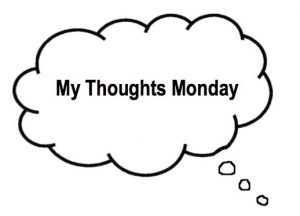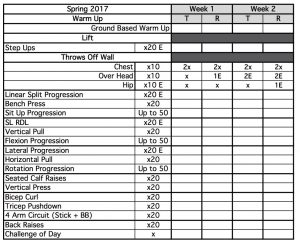 For those of you who know me, I’m a bit different with how I handle things in the weight room. We could talk about the 1×20 forever, but I think the main thing we should discuss is the autonomy I give to the student athletes. If we look at a lot of the lifts/exercises we ask these people to perform we as coaches would agree that they are general in nature, but we all fight over what we should do in certain “movements”. So with that in mind I’ll break down the initial card I gave to these student athletes that you can see below.
For those of you who know me, I’m a bit different with how I handle things in the weight room. We could talk about the 1×20 forever, but I think the main thing we should discuss is the autonomy I give to the student athletes. If we look at a lot of the lifts/exercises we ask these people to perform we as coaches would agree that they are general in nature, but we all fight over what we should do in certain “movements”. So with that in mind I’ll break down the initial card I gave to these student athletes that you can see below.
 The ground based warm up is just a bastardized version of the Parisi Warm Up Method. If you need to learn more about it please go to their page and purchase the video. It’s worth every penny.
The ground based warm up is just a bastardized version of the Parisi Warm Up Method. If you need to learn more about it please go to their page and purchase the video. It’s worth every penny.
Our primary lower body exercise right now is step ups. We selected this because our primary objective it to get “more fit” so I do not want to take too much away from our efforts to improve the student athletes fitness. Also, you saw on the last edition of MTM, they’re running a ton. I believe the squat is the “king” exercise as Louie Simmons has said, but I’m concerned that with all the work we are doing on our “fitness” that squatting will take away from that, or they will be too fatigued to really push the squats. We will squat once we get to shorter distance running (which we will talk about in a couple weeks), but for now, I’m not going to fight that fight and use this as a means to develop strength and endurance. A heavy set of 20 step-ups is a bear though, both to develop “fitness” and strength. If you haven’t tried it, please be my guest.
The throwing progression is to teach them how to be extensive with movements. We start with this and have had great success with this as a teaching tool to better help them to understand the running exercises that Verkhoshansky has discussed on many occasions.
Now the real questions you’re probably having. What are the progressions and why does it just say vertical pull and such. I’ll discuss the progressions next week. For now, let’s look at the general descriptions of exercises we have set up for this team.
Looking at the 1×20, I’ve noticed that many student athletes have a hard time looking at the forest through the tress. Meaning that they have a hard time seeing where they are going when just adding 5 pounds. So, we start out with the first 2 weeks having them understand that they are going to have the power to select some exercises. Namely, we give them the autonomy to select the upper body ones. This is because: 1) they’re general exercises that have minimal effect on actual sporting performance, and 2) because it allows them to invest more into the program because they are driving these decisions. We give them the 2 weeks to figure out that the goal is to get to a point where they can’t add weight, then just change the exercise. It’s really that simple. Push to the point of plateau and then change the exercise.
I’m sure people are sitting there shaking their heads now, but let’s really break this down. Let’s say this is a soccer team (it’s not, but just for arguments sake). How much does it really impact how they play soccer if they dumbbell bench, or barbell bench? Does it matter what type of pull down or if they do pull ups or chin-ups? I’m serious now. Ask yourself that question. Does it matter? Now ask yourself this, does it matter if they’re more invested and try harder because they want to do exercise x instead of exercise y that you want them to do? I think all of us would say that if they were more invested then they’d try harder and have greater returns on their investment. That’s why I do this. They try harder because they are invested. Now, when they get stuck and they ask, “what should I do next” do I lead them towards exercises that I’d want them to do? Of course, but at that point, they’re bought in (for the most part) so they’re willing to give on that situation for, at least, a little bit. So, when you look at the parts of the work out marked vertical pull, vertical press, and horizontal pull (and even bench press because that turns into horizontal pull) as long as it full fills that category (so a horizontal pull is a pull in that direction) I’m fine with it. To elaborate a bit more a vertical pull can be a pull down of any grip or attachment, a pull up/chin up of any grip it really doesn’t matter. Just pull something from vertically, get better at it, and if you stagnate, change the exercise.
That’s the honest truth when it comes to selecting those exercises. If we have fights that we know we have to fight, I’m not going to fight a kid over dumbbell rows vs. trx rows. Just not going to do it. What I am going to battle over is our progression of lower body exercises. That will be next weeks edition of My Thoughts Monday.
We are hoping to provide the best possible content for strength coaches with each of our shows. If feel this could provide value for anyone else in the strength and conditioning field please feel free to share.
Enjoy the content? Then you should check out The Strength Coach Network!
You can find sensational content just like this in The Strength Coach Network. As a member of The Strength Coach Networks, you can access over 200 hours of the highest-level lecture content just like this one for 48 hours for only $1. Follow the link below to sign up and use the code CVASPS at check out to get a 48 hour trial for only $1. Check out The Strength Coach Network Here! https://strengthcoachnetwork.com/cvasps/
#StrengthCoach, #StrengthAndConditioningCoach, #Podcast, #LearningAtLunch, #TheSeminar, #SportsTraining, #PhysicalPreparation, #TheManual, #SportTraining, #SportPerformance, #HumanPerformance, #StrengthTraining, #SpeedTraining, #Training, #Coach, #Performance, #Sport, #HighPerformance, #VBT, #VelocityBasedTraining, #TriphasicTraining, #Plyometrics

